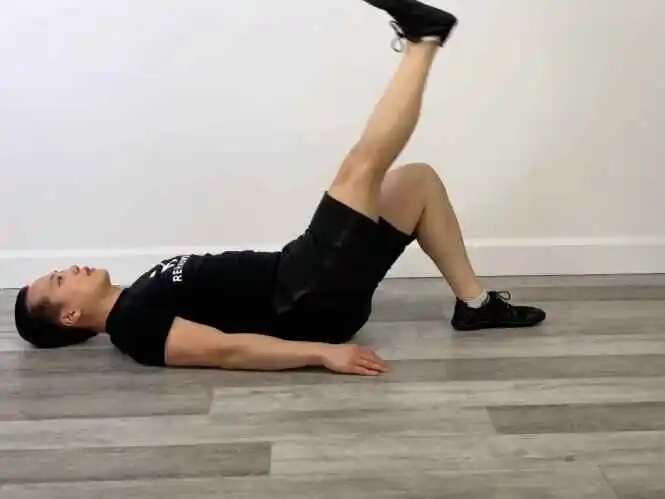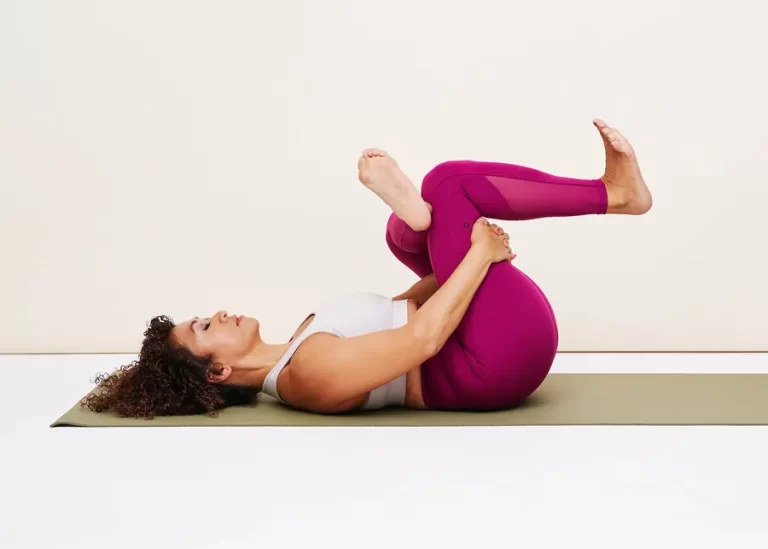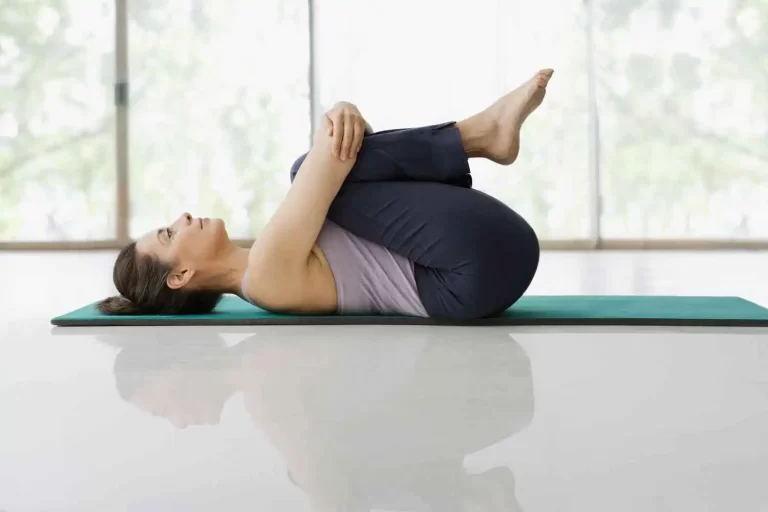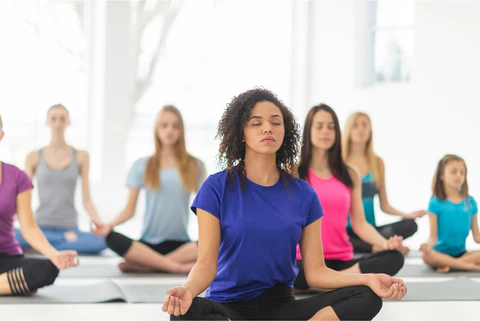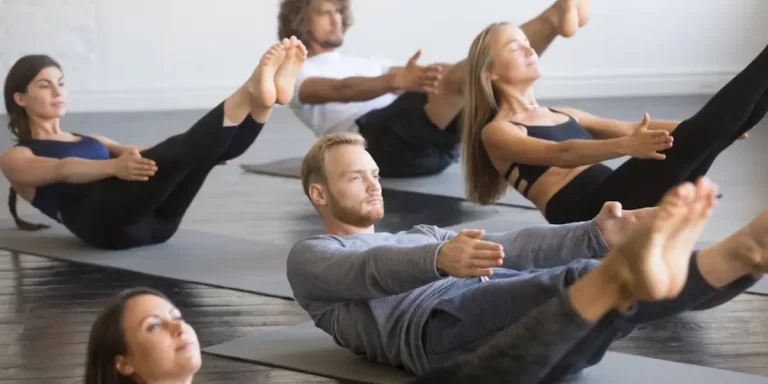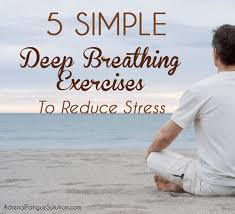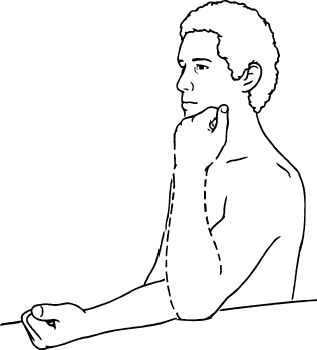17 Best Exercises for Osgood-Schlatter Disease
Introduction:
Exercises for Osgood-Schlatter disease are a crucial part of your overall treatment plan because they increase flexibility and mobility and help to strengthen your weaker muscles.
Osgood-Schlatter disease is a disorder that primarily affects young teenagers who participate in sports or other activities involving repetitive knee movements. It causes knee pain and swelling. Even while Osgood-Schlatter’s disease cannot be cured by exercise alone, several exercises can help control symptoms and encourage recovery.
Physical therapy is a very effective way for many individuals with Osgood-Schlatter disease to recover and get stronger after undergoing rehabilitation. Exercises for stabilization and strength are beneficial for increasing body strength.
To keep active and healthy, exercise should be a part of daily life. Exercises relieve knee pressure while improving your strength, flexibility, and balance. Exercises for the knee and hip are part of the Osgood-Schlatter disease physical therapy session. Exercises maintain the strength of your muscles, which might help minimize tension and strain in the body parts that hurt.
The advantageous:
Here are some advantages to frequent exercise;
- Regaining your range of motion may be helped by exercise.
- Maintain your good posture, or improve it.
- Minimize inflammation.
- Improved level of physical fitness.
- You can lessen joint stiffness by exercising.
- Long-term pain alleviation
- Increase the joints’ flexibility.
- Decrease any tightness or stress.
Exercises for Osgood-Schlatter Disease:
The finest exercises for Osgood-Schlatter disease that you can do are listed below.
Side-lying leg lift
- Your right side can be used for sleeping if you lie on the floor or a yoga mat.
- Legs lifted and feet put on top of one another will help you maintain a straight posture.
- Alternatively, you can hold yourself up by holding your arm straight above your head or with your elbow bent.
- Leg up off the ground with your left.
- Don’t raise your leg anymore once you feel the muscles contract.
- Hold this position for a few seconds.
- After inhaling deeply several times, pull the leg down until it contacts the right leg again.
- Then return to your neutral position.
- Then relax.
- Repeat this exercise 5 to 10 times.
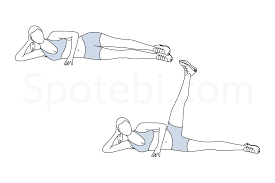
Prone Quadriceps Stretch
- Lie down on your face.
- Raise your right forearm to the front to offer support.
- With your left hand resting on your shin or ankle, flex your left knee inward.
- Raising the knee just a little bit will cause just a little stretch.
- Hold this position for a few seconds.
- Then return to your neutral position.
- Then relax.
- Repeat this exercise 5 to 10 times.

Gastrocnemius Stretch
- Using a wall or the back of a chair as support, carefully take a step up.
- Now take a step backward.
- Continue moving to plant your feet flat.
- Flex your front knee until you sense a stretch in the calf of your back leg while keeping your back straight and your heel down.
- Hold this position for a few seconds.
- Then return to your neutral position.
- Then relax.
- Repeat this exercise 5 to 10 times.
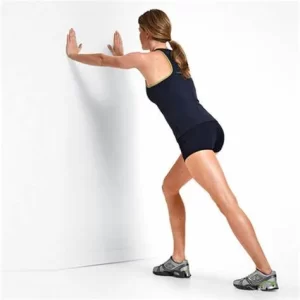
Straight leg raise
- To begin, take a comfortable seat and lie down on the floor or a table.
- Flex your knee slightly now.
- Next, gradually elevate your one leg.
- On the other side, maintaining a straight knee.
- Hold this position for a few seconds.
- Then lower your leg.
- Then return to your neutral position.
- Then relax.
- Repeat this exercise 5 to 10 times.
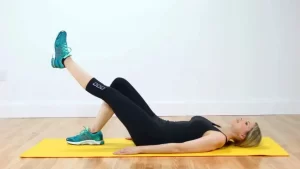
Lateral banded walk exercise
- The band should be flat and not twisted as it is wrapped around both legs, slightly above each knee.
- Set your feet apart so that they are shoulder width.
- The band should be tight but not overly stretched.
- Your gluteus medius will contract when you slightly bend your knees and go into a half-squat.
- Facing forward, maintain your feet parallel to your shoulders and your body weight evenly distributed across both feet.
- While keeping your half-squat posture, shift your weight over one leg and move your other leg sideways.
- For five to ten repetitions, move this leg sideways in and out.
- Throughout the exercise, maintain your hips level.
- Maintaining a low, forward-facing posture is helpful when performing this exercise.
- Change your legs and your weight gradually.
- Then return to your neutral position.
- Then relax.

Quadriceps wall Squats
- Initially, position yourself near the wall.
- Keep your feet planted on the ground.
- Back up against a wall, if possible.
- Keep the distance between your feet equal to your shoulder’s width.
- Keep your back and pelvis against the wall as you slowly bend your knees.
- Don’t push yourself too much.
- Hold this position for a few seconds.
- Then return to your neutral position.
- Then relax.
- Repeat this exercise 5 to 10 times.
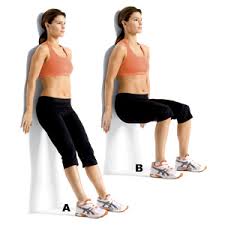
Step up
- Begin in a comfortable standing posture.
- Put one leg on a platform, at the bottom of a stairwell, or at the base of a step bench.
- Keep your height at your pelvic level.
- With your opposing foot, progressively lower yourself to the ground while bending at the knee.
- After placing your big toe gently on the ground, step back up to regain your position.
- Then return to your neutral position.
- Then relax.
- Repeat this exercise 5 to 10 times.

Clamshell
- You begin by lying on your side.
- Bend your elbow while lying on your left side.
- Next, raise the support to your head with your left hand.
- Place your right foot and leg atop your left, then bend your knees to a 45-degree angle.
- Afterward, slowly lift your right knee toward the ceiling while keeping your feet close together.
- Keeping a tight core, raise your lower right leg back up to meet your left.
- Hold this position for a few seconds.
- Then return to your neutral position.
- Then relax.
- Repeat this exercise 5 to 10 times.
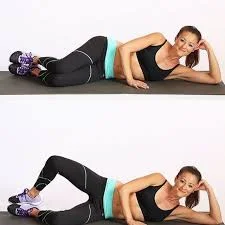
Leg extensions
- Initially, sit upright in a long chair.
- Look straight ahead, tighten your thigh muscles, and raise one leg as high as you can to build strength without raising your bottom off the chair.
- Hold this position for a few seconds.
- Then return to your neutral position.
- Then relax.
- Repeat this exercise 5 to 10 times.
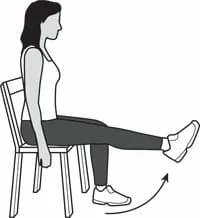
Standing quadriceps stretch
- Begin with a comfortable standing position on the floor.
- Either maintain your left arm by your side or raise it straight in front of you.
- This helps keep things in balance.
- The patient can modify this exercise by gripping onto the back of a chair or wall if they find it challenging.
- Grasping your left ankle, bend to your left knee.
- Bend with your left foot behind your body.
- Putting your hand on the ankle, try pulling the leg up and back.
- Verify that your complete body is in the proper position.
- Hold this position for a few seconds.
- Then return to your neutral position.
- Then relax.
- Repeat this exercise 5 to 10 times.
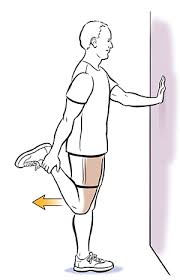
Side-Lying Quadricep Stretch
- Start by finding a comfortable spot on the ground to rest your side.
- To bend the knee of your upper leg as far as possible, gently pull with your hand.
- Hold this position for a few seconds.
- Then return to your neutral position.
- Then relax.
- Repeat this exercise 5 to 10 times.
- Repeat the exercise with a different pair of legs.

Static-quadriceps-exercise
- Laying or sitting on your back with support for your back, extend your legs straight in front of you.
- Place a little towel below your knee and twist it up.
- As you tilt the first foot slightly to the side, bring the other foot towards you.
- Your thigh muscles will tighten as you firmly press your knee down.
- Hold this position for a few seconds.
- Then return to your neutral position.
- Then relax.
- Repeat this exercise 5 to 10 times.
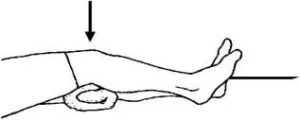
Seating hip abduction
- Arranging yourself in a straight bench.
- Your knees should be hip-width apart when you place a resistance band around them.
- Make a controlled movement by slowly pushing your knees out to the side and back in.
- Hold this position for a few seconds.
- Take your time, and keep your posture straight throughout the exercise.
- Then return to your neutral position.
- Then relax.
- Repeat this exercise 5 to 10 times.
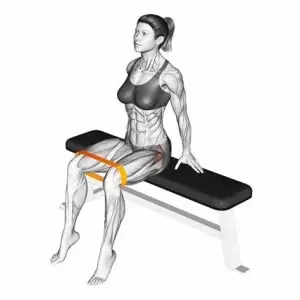
Hamstring stretch
- Begin by lying down on the yoga mat in a comfortable position.
- With the knee bending slightly, raise one leg off the mat.
- Secure the heel of the extended leg with a resistance band.
- As close to your chest as feels comfortable, move your leg in.
- Hold this position for a few seconds.
- Then return to your neutral position.
- Then relax.
- Repeat this exercise 5 to 10 times.
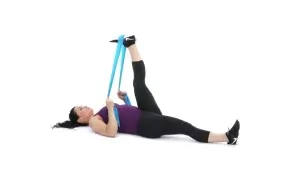
Bridge
- Spread your legs wide apart and place your feet firmly on the ground while lying flat on your back.
- Laying down your hands and keeping your arms by your sides.
- A small pillow should be placed under it if head and neck support is required.
- Up your pelvis step by step until you get to your back.
- It’s vital to keep your shoulders and upper body firmly planted on the ground.
- Hold this position for a few seconds.
- Lower yourself into the spine until the whole back is flat against the floor again.
- Then return to your neutral position.
- Then relax.
- Repeat this exercise 5 to 10 times.
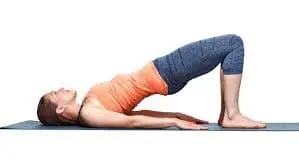
Seated calf stretch
- To start, find a comfortable spot on the ground to sit.
- Keep your knees straight at all times.
- You can wrap the front of your foot with a resistance band.
- Maintain that position by keeping your leg level with the floor.
- You can feel the muscles in your calves stretching.
- Hold this position for a few seconds.
- Then return to your neutral position.
- Then relax.
- Repeat this exercise 5 to 10 times.
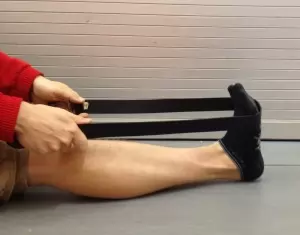
Standing hamstring stretch
- Stretch your leg while standing, using a chair, table, or other sturdy object as support.
- Ensure that the leg you are stretching is facing your hips and pelvis as well.
- Avoid stooping over at the shoulders.
- Do not let your toes drop.
- Your thigh should feel stretched in the back.
- Hold this position for a few seconds.
- Then return to your neutral position.
- Then relax.
- Repeat this exercise 5 to 10 times.
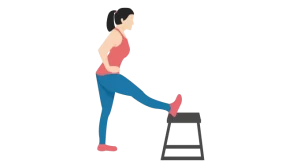
What safety measures are necessary when exercising?
- Be sure to keep your posture straight when doing your exercises.
- Take a break in between activities.
- If you have any unexpected pain when exercising, stop.
- Make gentle bends and stretches.
- Exercise is best done in loose, free clothing that promotes mobility and relaxation. Avoid wearing tight or stylish clothing.
- Although it may be challenging, stretching the tense muscles is normal and even required. Stabbing or painful feelings should never be experienced during stretching or exercise as this is dangerous and exacerbates the problem.
- Stay away from doing hard exercises.
- The protocol should be followed for every exercise, including instructions for proper repetitions and stretches before and after.
When don’t you work out?
- You have extreme muscle-burning
- Fever
- Headache
- If engaging in exercise causes pain
- You’re feeling unwell
- Swelling
- Blurry vision
Which types of exercises should you avoid if you have Osgood-Schlatter disease?
- Exercises using high forces
- Fully squatting
- Activity including stair climbing
- Jogging
Summary:
Teenage athletes as a whole are known to have Osgood Schlatter’s disease. This condition is more common in men who play sports that require jumping, sprinting, or kicking.
Exercise for Osgood-Schlatter disease can help with strength, flexibility, and balance while physical therapy works to alleviate disease-related symptoms. Customized exercise programs can be developed with help from a physical therapist. Calf stretches, quadriceps, and hamstring exercises are a few possible exercises. There may also be exercises focused on strengthening the muscles in the legs and improving balance.
FAQ:
How may Osgood-Schlatter’s disease be avoided?
Your exercise program can help prevent Osgood-Schlatter disease by strengthening and extending the muscles surrounding your knee joint. Exercise strengthens and increases bone density in the muscles and bones.
Is exercise beneficial for Osgood-Schlatter’s Disease?
By exercising, you may improve your health.
Exercise is essential for Osgood-Schlatter Disease because it strengthens the bones and muscles.
How quickly can Osgood Schlatter recover?
Osgood-Schlatter disease can be treated using kneepads or a patellar tendon strap, cooling the sore area, anti-inflammatory medications, and minimizing activities that worsen the condition.
Can I squat with Osgood-Schlatter Disease?
For Osgood Schlatter, squatting is not a bad thing, but the way you do the exercise affects whether the outcome will be favorable or unfavorable. The most common error we witness in athletes is attempting full-depth squats. It’s better to go with shallow, safe squats instead.
For Osgood Schlatter, is it more effective to be cold or hot?
To alleviate pain and swelling, apply a cold compress for ten to fifteen minutes every two to three hours or after any movement that worsens symptoms. Ice packs or massages can also be used. Heat can be applied during stretches and strengthening exercises as directed by your physician or athletic trainer.
What shouldn’t I do with Osgood Schlatter?
For the most part, children with Osgood-Schlatter disease only require at-home therapies, such as Rest: Your youngster should refrain from participating in sports or activities that are irritating their knee. A doctor will advise you on how long the kid should wait to play sports. It could take a month or two, or it could only be a few weeks.
Is Osgood helped by stretching?
Using a foam roller can help relieve tension in the knee joints. Additionally beneficial for adolescents with Osgood Schlatter Disease who frequently experience knee pain is stretching to increase hip range of motion.
What would happen if Osgood wasn’t given any medical treatment?
Due to the chronic nature of Osgood Schlatter, there are three main reasons why the condition usually does not improve on its own. A meniscal tear or a collateral ligament injury are examples of what you’ve developed, not Osgood Schlatter.
Does Osgood-Schlatter never go away?
Osgood-Schlatter disease typically resolves in young people and teens without causing long-term health problems. Their knee joint and bones sustain no long-term harm as a result of it. Once the growth plates harden into adult bone and the muscles surrounding the knees are strengthened and stretched, children grow out of the condition.
What is Osgood Schlatter’ level of pain?
One common symptom of Osgood Schlatter disease is pain and swelling below the kneecap. Generally, the pain gets worse when you run, jump, climb stairs, or walk up hills. One may indicate severe pain by limping.
References:
- Physio, S. (undated). The top 5 workouts for Osgood-Schlatter syndrome – Surrey Physio. At Surrey Physio. Best 5 exercises for Osteotrophic Sclerosis: https://www.surreyphysio.co.uk/top-5/
- On May 6, 2023, Pt., B. S. Osgood-Schlatter Disease Exercise Program. Very well Medical. An Osteogood Schlatter disease exercise program (4018922) can be found on Very Well Health.com.
- December 13, 2023a, Bariya, D. The Top 15 Osgood-Schlatter Disease Exercises – Mobile Physiotherapy Clinic. Mobile Physio. https://mobilephysiotherapyclinic.in/15-osgood-schlatter-disease-exercises-best/

